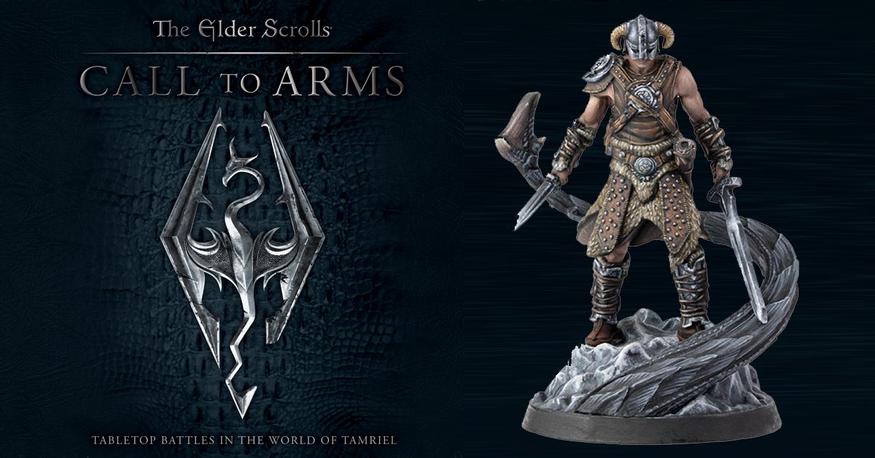At the start of The Elder Scrolls: Skyrim, the player arrives in the game in shackles, as a slow cart meanders its way through mountainous terrain. NPCs with dubious voice acting bicker as you ride forward, and the game scrambles to establish the key story beats in a few precious seconds. Stormcloaks, Imperials, High King, Helgen, all of these ideas are thrown at you in a lump, and then you’re dumped out the other end to stop and fiddle with appearance sliders for half an hour. It’s only once you’ve had your execution interrupted and you can flee the burning city that the game really begins. Well, not really, it’s more that the game really begins when you find and kill your first dragon and get your first shout. I think. It’s hard to tell.
Skyrim is a game with a lot of false starts, and where as a player you spend an awful lot of time not doing much before you get to do anything really cool. It’s very much the Fallout 3 problem, and it’s notable that there are plentiful popular mods to let you skip the opening.
When I tell you that The Elder Scrolls: Call to Arms is a painfully faithful recreation of Skyrim in tabletop form, you should understand it in that context. Skyrim is a beloved game that millions of people have spent hundreds of hours exploring and enjoying. So too in TES:CtA is there a fascinating, crunchy, exciting game, but just like with Skyrim it’s walled up behind a painful slog to get to the interesting stuff. The end result is a game that it’s hard to recommend to anyone except the most die hard Skyrim fans, because only they are likely to have the patience to push through.
First Steps to Adventure
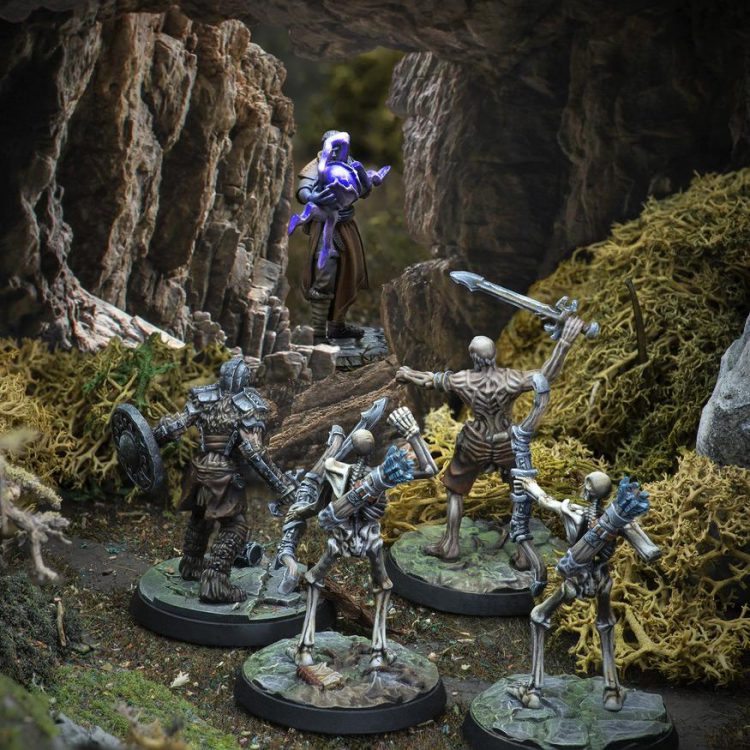
The Elder Scrolls: Call to Arms is a tabletop miniature game that can be played competitively by two people (in battle mode) or cooperatively or as a solo game (in delve mode). It’s produced by Modiphius Entertainment—who also make the Fallout miniatures game we reviewed—as well as roleplaying games like Star Trek Adventures and Achtung Cthulhu. It’s designed for play with a handful of miniatures controlled by each player, with some wandering monster miniatures appearing. This puts it firmly in the skirmish scale category and it’s played with 32mm scale miniatures with relatively realistic proportions (making them skinnier and a little taller than Games Workshop products).
The product selection is a little unusual, and you’d be forgiven for assuming (as I did before it arrived) that the core rules box included miniatures and enough stuff to play; unfortunately this isn’t the case. The beautifully made, dense, heavy box of rules is literally just the rules. Tokens, cards, a paper battlemat and three rulebooks make up this package. It’s a huge mountain of stuff, more akin to the accessories you find in a lavish kickstarter boardgame (and we’ll come back to that later).
The miniatures themselves you have to buy separately, and that’s… a bit rough. You basically need the Bleak Fall Barrows Delve set to even play the tutorials, so you’re going to have to pick that up. But that’s not actually enough to play a battle game, so you’ll also probably want to grab some Stormcloaks and Imperials too. That makes the “starter bundles” that Modiphius sell with a rules box and the three most basic minis boxes included a sensible purchase but the price tag… well, we’ll come back to price later. The miniatures are also available in plastic and resin, and while I didn’t get any of the plastic miniatures provided to review, it’s clear from other reviews and from the Fallout minis that we received that their quality is not fantastic. The resin miniatures on the other hand, are absolutely stunning but… well, we’ll come back to that too.
If you head over to the Modiphius store you might notice that Escape from Helgen (the tutorials) and the core rulebook are available as free PDF downloads, with the Quests (scenarios) being a download that costs the same as a fancy coffee. There’s even a print and play file for the custom dice. You might even grab some minis and think that means you can get playing right away but… no, you can’t. Because the entire game revolves around the plethora of cards, and those are only available in the core rules box. So you’re going to have to splash cash on that to even just play the tutorial.
So let’s assume you have your Bleak Fall Barrows Delve set and the rules. Now we hit some good news, actually some great news. The Escape from Helgen tutorial booklet is absolutely fantastic. It’s a series of three linked tutorial scenarios using literally just a couple of miniatures, with premade decks. Each one teaches you some core concepts, introducing more and more of the game in each of the tutorials. By the end of the booklet—which doesn’t take more than an hour to set up and play through—you’ll have the basics down of how checks work, how you move, what actions you can do, what the most important bits on each card do, and so on.
It’s hard to fault this as a tutorial packet – it’s evocative, narrative, well-paced and easy to read and play with. At the end there’s a little quick reference page which I continued to use the entire time I played. It also concludes with the words
“When all the tutorials are complete, it’s time to open the core Rulebook. You are now ready to learn the full rules.”
Which marks the point where the onboarding process of the game really falls down.
A Slightly Too Open World
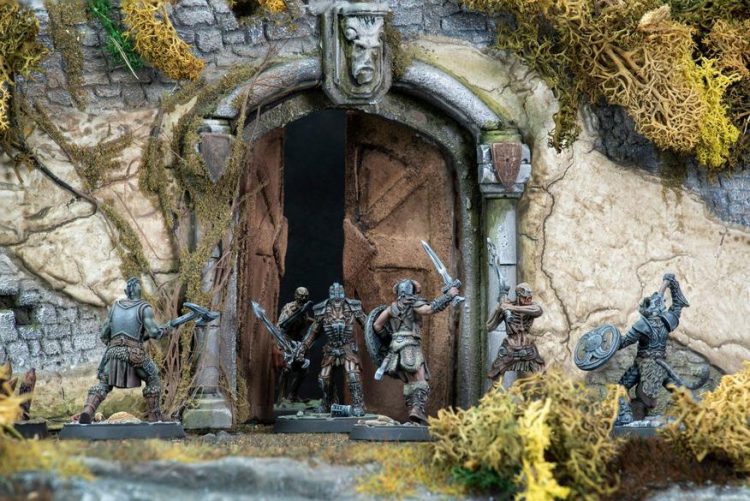
When you look at the rulebook itself you might be forgiven for thinking that it’s actually not too intimidating – after all, many wargames have a huge rulebook! This one is little, a half size paperback with only about 100 pages. Surely this will be a breeze, after all we just played through the tutorials.
What you’ve not realised if you have these thoughts is that this little book is absurdly dense. First of all, unlike many rulebooks there is effectively no background or lore material of any kind—it’s assumed you know what the setting is. This is a good indication of their target market in many ways. The game always presumes that you have played Skyrim and know what The Elder Scrolls is as a setting, and doesn’t spend any time explaining it to you. But that means that all 100 of those pages are rules.
Another way that these books can often end up looking lengthier than they are is in the inclusion of lots of spacers – photos, illustrations, chapter splash pages, all that stuff. There’s very little of that here; probably less than four full pages of art across the whole book. You might not realise this flicking through though, because the pages are very colourful, packed with lots of diagrams and tables with coloured entries, and custom symbols and all kinds of other visually provocative stuff. That does pose some problems as well however, because with the cramped font, dense text and busy visual style it can feel pretty overwhelming. The best thing I can say about the layout of the rulebook is that the small form factor makes it easy to take places and carry around.
One of the challenges with reading the book is that it doesn’t really explain things in a top down way. It opens with giving you some basic information about the components and conventions used, but this quickly devolves into incredibly detailed and dense descriptions of all the element of a character card, or an upgrade card, and these are not simple components. We make it through here and we get to the skill test, and how that works… but then we stop for an overview of attributes, and then there are modifiers, and substitutes, and effect dice, and there are two half-page tables to explain what the custom dice results mean. It’s a brick wall of information, and we’re only on page 9 of 101.
If you fight your way through all of this though, you remember that… you’ve already played the tutorial! You know this already! Right? Well, mostly. One thing that the tutorial does well is give you a sense that you know what’s happening, but one thing it does badly is mislead you into thinking that means you know what’s happening in the game proper. Sure, the basics are the same, mostly, but there’s so much stuff in the core rules that it’s hard to tally the tutorial with them.
One of the biggest complaints of Skyrim is that it sometimes felt too big: too many options, too little direction. Lots of people loved that, wandering off, making their own fun, finding things in the world that weren’t the main quest, but others felt frustrated or overwhelmed at the sheer scale of options. Call to Arms replicates this sensation faithfully. There’s just so much stuff in this game to get to grips with. This is a miniatures game with 5 attributes and 19 skills, with skills having a plethora of associated perks. Some of them have upwards of 15, and even the leanest has half a dozen. Each of these is a rule, listed in block text, that you have to reference. They’re not listed on the character cards. You have to know what the perk is and what the symbols mean and look them up.
You can do almost anything in this game that you can do in Skyrim, but that is actually a huge problem. The open nature of the game, the huge number of possibilities, will excite and thrill some players, but overwhelm and frustrate others. As a veteran of dozens of wargames, complex and simple, I found my head spinning at the sheer amount of stuff on offer. But if the idea of having a character who can smith an axe, enchant it, block a hit with a shield, then instantly eat a wheel of cheese to regain fatigue all in the game appeals to you… this is probably a plus, not a minus.
A Slightly Too Empty World
Now we’ve established that Call to Arms has a wild abundance of toys to play with, it’s time for us to look at if doing that is actually fun.
Those 19 skills don’t actually all tie into actions – just like in the video games, some of them (like light and heavy armor) are more permissions and buffs than anything else. Light Armor “allows the model to fight while wearing Light Armor” and that’s a pretty good description of what it does. Others are actually tied to specific actions, like lockpicking and block. These all have their own rules, kept with the other more generally accessible rules, and these are probably the best skills in my opinion – they give you more cool stuff to do. Equally, the magic skills let you cast spells, and that’s great, though they are much less available than it feels like they are when you play the video games, because you can’t dip your toes as easily into them.
Magic is of various flavours (alteration, conjuration, destruction and illusion in the core book) and spells cost magicka to cast from a pool. There are a variety of different ways of targeting them, and some specific subtypes of spell. I like these specific types the best, perhaps, but it’s probably not necessary to go over them in detail on the grounds that these are the spells in the videogames. They work in basically the same way, have the same strengths and weaknesses, and do what you expect.
Dragon Shouts are another completely faithful adaptation of the video game lore. It feels oddly niche to include a whole system for something that literally one character in the game can do, but I guess you gotta hit that licensing button as hard as you can when you snap up something like this. They’re fine, but again they do what you think they would, and mechanically work basically exactly like spells but without a magicka cost (they cost a currency called Thu’um instead).
Now we come onto perks, and holy crap there are a lot of perks. You can be a sneaky character who is sneaky with daggers, or with bows, or that can walk over traps without setting them off, or which make it harder to hear them when they’re walking, or which can run away really well, or… you get the idea. Every single one of these things is a perk, and I haven’t listed all the effects by a long shot and that’s just one skill. Sneak doesn’t even have the most perks, not by a fair way!
There are so many of these and they can basically be broken down into two categories:
- Let you do a thing you couldn’t do, or gives you a special rule you couldn’t normally have
- Gives you a bonus or your opponent a penalty
That’s it. There are not exciting subsystems, or new play opportunities. You want to be really good at sneak, and take all the perks? You’ll be able to hide really well and move fast when you’re hidden and your opponents will not be able to hear you and you’ll be really good at sneak attacking in a bunch of ways. And that’s it. Which is cool, but it feels a little flat – the basic rules cover everything, and these little buffs and changes definitely make characters different, but I never felt joy at my character’s perks. I never went “Oh yes, I have x!” like I do in some games. I spent a lot more time going “Oh, I’ve rolled the wrong dice on that test, because I have [insert four different perks here]”.
So we have this dizzying array of not hugely interesting rules and oh no you thought we were done we’re not done. Not by a long shot. Because this is Skyrim I mean The Elder Scrolls and this game is going to faithfully reproduce everything in there whether you want it to or not. That means racial bonuses, that means equipment, potions, food, money if it’s in the video games, it’s in here. Every single one of these things has rules, and options, and the cards mostly just tell you the name of the thing and expect you to remember or look it up every time.
Here’s a character card for Hadvar, with upgrades in tow:
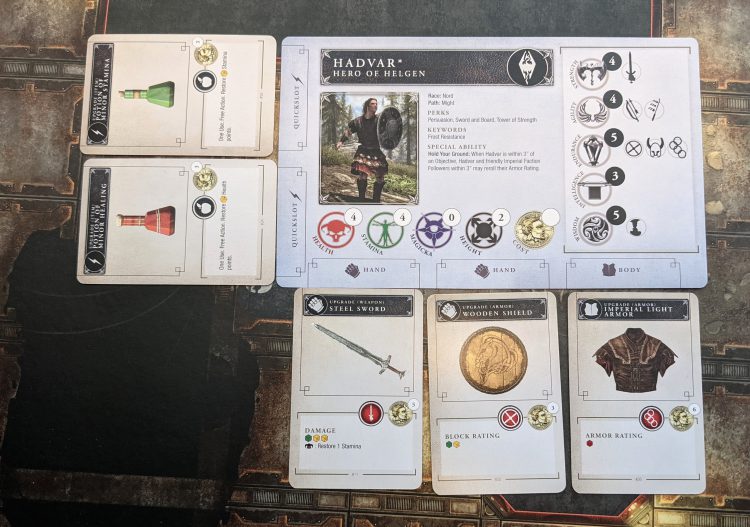
Now this is probably the most complex looking card you’ll have in your party – less important models get less stuff, but they all get stuff and just look at how much stuff is on Hadvar’s card! It’s overflowing with stuff. And this isn’t the most complicated a card can get – there are characters with special rules, more perks, more skills, all kinds of stuff.
And you can see here as well how the symbols and notations don’t help at all. Persuasion, Sword and Board, Nord, Frost Resistance, the little picture of a bow and the little picture of a lockpick, they all do stuff. They all have rules. Rules that I found myself looking up again and again. And so much of it basically amounts to “Oh I should have rolled an extra die on that test”.
One of the major criticism of Skyrim was that it had this huge sprawling world, and it all felt very empty. It often felt like the same town copy-pasted again and again, to give the illusion of space and complexity, without really following through on much of it. In this way as well, Call to Arms is very much an authentic adaptation. Again, for many people they didn’t care and they won’t here either. Lots of people get a real thrill out of counting up all the dice to roll, and pooling all your cool bonuses to get to win out, and if that’s you, you’re going to love this. If it’s not, then you’re going to feel pretty exhausted by the entire affair, this huge hill to climb to find at the top there’s mostly more hill.
Comrades in Arms
One of the big appeals to me about this game was delves. Battle mode plays out a lot like most wargames – you have a bunch of scenarios, you have deployment zones, you’re trying to attack each other and that’s basically it. There’s an interesting twist in that you might have some random baddies wandering around, and often you’re attempting to contest exploring something or taking some treasure, but ultimately it’s the kind of fare you’ve seen before.
Delves on the other hand are something more unusual – a true cooperative or solo enterprise. I don’t want to bury the lead here, so I’ll say right up front that this is the most responsive, most challenging and most consistently playable adversary system I’ve seen in a miniatures game. At no point did I feel like I didn’t know what to do with the enemies, and they acted in what felt like plausible, challenging ways. I really enjoyed my solo games, and a big part of that was the adversary system.
Now the bad news. The system accomplishes this by doing what it does in every other part of the ruleset: stuff. In this case, the stuff is mostly flow diagrams.
I don’t want to make it seem like I think this is a bad solution – it’s not. The diagrams were helpful, and really helped modulate the game. But there are a bunch of them, for lots of different situations, and the rules for antagonists are one of the meatiest parts of what is a very protein rich book. I certainly wouldn’t want to try and play them with someone who wasn’t an experienced gamer, or whose tolerance for stopping and looking things up was low.
That said, when I got the hang of it, it was really good. It felt more organic and realistic than other systems, and soon I was slapping draugr with swords and nicking their stuff, and it felt pretty fun. As a coop game it’s also a nice addition – I haven’t quite convinced my husband to play with me, but I’m definitely planning on roping in some boardgaming friends when lockdown lifts to give it a spin.
Overall, if you buy this game as a solo or coop project, that might be the way to do it. On your own you’re not waiting for other people to puzzle out what their models do. And played cooperatively you can help each other out navigate the jankier elements of the rules, and get things playing more smoothly. This really feels like how the game was supposed to be played, and it makes sense that Modiphius have consistently given it equal top billing, and not pushed the competitive angle too hard.
Modelling Adventure
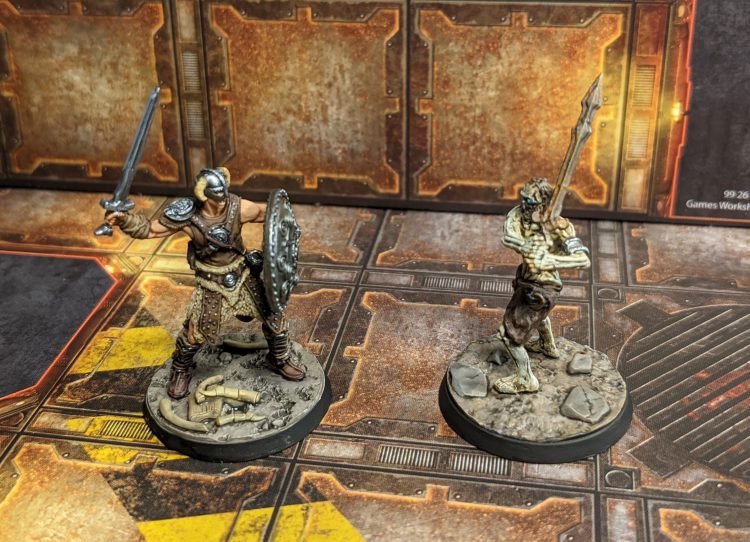
In my big exciting box from Modiphius I was provided with the Resin Starter Bundle – that’s the Delve set, Stormcloaks and Imperials, all cast in high quality resin. I’m going to talk about them altogether because these are honestly some of the most consistent resin miniatures I’ve seen in terms of quality, and there’s little to pull apart between the sets (this is a good thing).
First of all the casting quality is absolutely stunning. I’ve only ever had resin miniatures this good from Atlantis (which, it turns out, uses the same caster), and those are my go to recommendation for people who aren’t sure if resin can be a good material for minis. The detail is crisp and fine, the casting is excellent, with minimal flash or slip. The pieces, once washed and cleaned up just a little, were ready for spraying without almost any fuss, and come as a couple of pieces in most cases.
The detail on these is absolutely breathtaking. As a technical sculpting and casting enterprise, I’ve rarely been more impressed—these are some of the best miniatures from a pure quality standpoint I’ve ever worked with. They are so intricate and perfect that I found myself intimidated by the sheer task of doing them justice.
Which leads into one of the major negatives about them: they are too complex in some ways. As a veteran painter who doesn’t baulk at many tasks, I was absolutely overwhelmed by the detail on these. Each model was a serious undertaking, and there are few good easy surfaces that take washes well and give you a break. Every part needs careful, considered painting and detailing to really make it shine. I play every day and it was a challenge; for a new hobbyist I imagine it would simply feel impossible. It’s difficult to know who these are for, because they feel like the best possible quality display resins, but equally you need a bunch of them and the IP feels best geared to drawing in people who wouldn’t normally play minis games.
As I didn’t receive the plastics I can’t comment directly, but the issues with Modiphius’ plastic miniatures are well documented (including on Goonhammer), and the sculpts will remain the same, so I don’t see them getting easier to paint.
I’m thrilled to own these miniatures, and I’m very pleased with how they look painted up, but they were an enormous time and effort sink, and I can’t say I plan to pick up any more, even just as a hobby project.
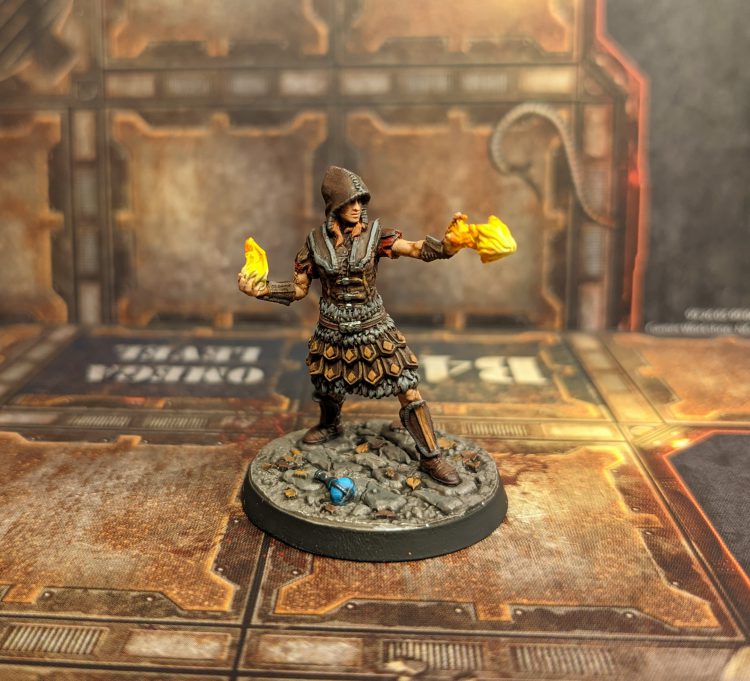
Victory… but at what cost?
So we can conclude that Call to Arms is a complex, labyrinthine, vast miniatures game offering an insane array of possibilities. It is probably the most faithful adaptation of an IP I’ve ever seen in a game, offering you the ability to mimic the play of Skyrim in particular almost exactly. It feels like the videogames it’s based on which is a real achievement.
Unfortunately, the big market of “people who really like Skyrim” that might be tempted to pick it up are likely to be put off by the complex detailed miniatures, the vast number of rules, and the uphill struggle to learn what everything does.
For people who are gamers first, I can really recommend this if you want something crunchier and more “minis games” than what most coop dungeon crawler boardgames can offer, but probably not for any other reason.
The true market is the small slice of the piece which is “people who really love Skyrim even a decade later” and “people who are really into miniatures games and don’t sweat a lot of complexity”. If that’s you, then I cannot recommend this game more – you will absolutely adore it. But for anyone else? It’s a hard sell, particularly because of the price tag.
If you want what I got, the Resin Starter bundle, you’re looking at £115, and that’s a big wedge of cash for what is, out of the box, surprisingly limited. You can’t really do full sized battles with just that starter. Looking at what I’d want to play this competitively I totalled up another £70 at the very least, and really you want to spend another £70 on top for the extra stormcloak and imperial boxes… that aren’t even out yet. Oh, and to play with those you’ll need another card set and expansion, and that costs money too.
In the end then, this is a game for people who are dab hands with games, loved Skyrim, and don’t mind blasting money like a firehose now and in the future. That’s a tough sell for me, but if you’re in the position to drop a lot of cash and Skyrim is one of your touchstone properties, I can definitely see why you’d jump at it.
A review copy of the materials covered in this article were provided by Modiphius.
